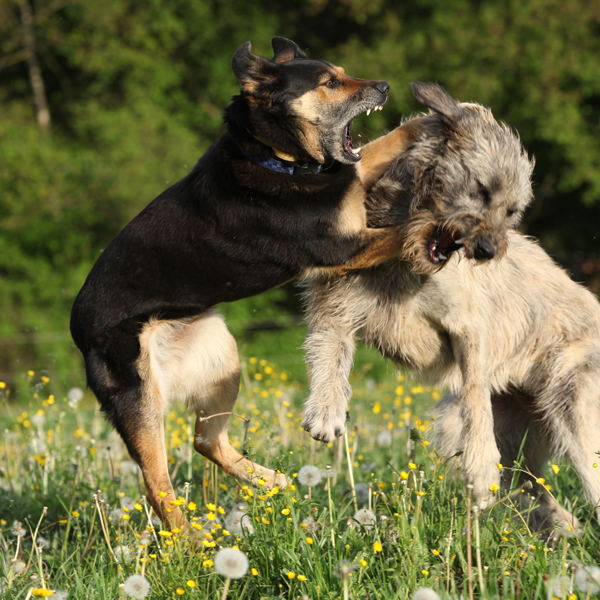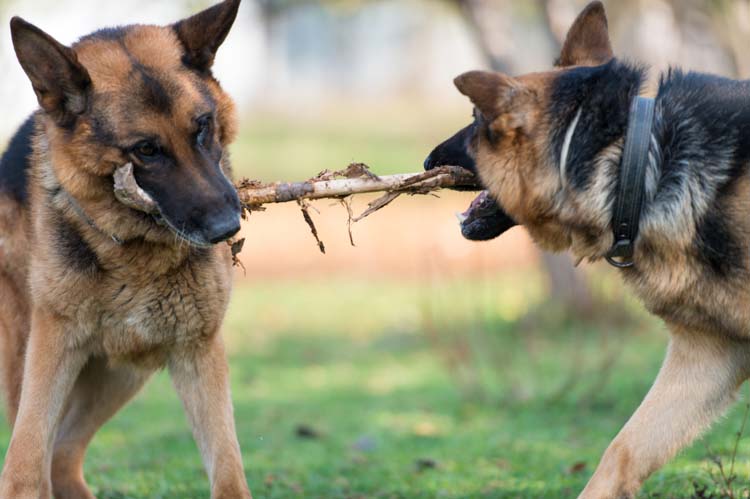Reasons for Aggression in Dogs

The stories show up in the news nearly every day—someone was attacked by her dog, another dog was attacked by a dog or a child was bitten by a dog. The public begins to think that all dogs are vicious, trainers look at the ways they could have been avoided and animal lovers rise to the defense of the animal.
More than 4.5 million people are bitten by dogs each year, according to the American Veterinary Association of America (AVMA). Considering there are 70 million dogs in the USA, these stats show we need to do more on all levels; from educating the public on how to work with animals to teaching children how to recognize dogs’ body language and signals.
Under most circumstances, bite cases can be summarized into three categories:
- A lack of veterinary care for dogs suffering from a medical condition
- Children who have not been taught to read animal behavior
- Multi-dog households with owners who are not trained in working with multiple pets
Pet aggression can stem from a variety of causes. These are the more common reasons for aggression in dogs. Once you understand the causes, you can start learning the solutions.
Pain Aggression
One of the most common causes of aggression in pets is a result of the dog being in pain. Since associative learning is a dog’s most important way of learning, it can result in long-term damage to the dog and the owners. The most obvious solution is to have the dog medically evaluated.
Multi-dog Households
If you have more than one dog in your home, you are five times more likely to be bitten than a home with only one dog. This is largely due to owners reaching in to break up fights between dogs. This is a problem that can only be solved by educating owners on how to live within a multi-pet household. Fortunately, there are many good sites that focus solely on this problem, and plenty of material that you can share with family members.
Side Effects from Medication
There are hundreds of medical conditions that can stimulate biting behavior in pets. In many cases, pets have sustained damage before they were even brought them into a home. But more commonly, aggression can be caused by side effects from prescription medications. Check with your veterinarian and pharmacy to learn which types of medications are most likely to encourage aggressive behavior.
 Fear Aggression
Fear Aggression
Just as screaming or striking out at someone who surprised you would be considered a perfectly normal response, dogs react with the same instinctual response. Since children are fond of “sneaking up” on a pet, this is one more reason why most bites occur in kids. Threatening a dog, negative training methods or lack of socialization can cause a pet to react in fear.
Children
From 2010 to 2012, there were 359,223 reported bites in children. 57 percent of these children were between the ages of 5 to 9. Sixty-six percent of these injuries were to children 4 years and younger. This is just one more reason it’s so important to teach children how to understand dogs at a very young age or keep them separated from dogs until they can learn how to read them. There are many child-friendly books, diagrams and infographics that are free to download and available from a variety of sources. Simply search on “Body language of dogs” and print one out. It’s free and it could save a child or a pet’s life.
Behavioral Aggression
Behavioral aggression can include everything from resource guarding to frustration aggression. Dogs are naturally territorial and if your pet perceives you as the cause of a resource being withheld, you could be at risk for a bite. This is one more reason it’s so important to socialize and train pets. Dogs learn by association and once they have successfully used a negative reaction (biting) to obtain results they want (food or a toy), they will begin to do it more often. Dogs learn by association, which is why it’s so important to integrate positive training approaches.
Genetics
There is a lot of controversy about breeds that bite. Breed Specific Legislation (BSL) is rampant on a global level, particularly in regards to the “bully breeds.” While it’s true that many bites occur from bully breeds, the facts are rather skewed. Often, a smaller dog’s bite is not reported because of the minor damage smaller dogs inflict. However, a large-breed bite is nearly always reported due to a larger bite radius and therefore increased damage. Bully breeds tend to get most of the blame due to selective breeding in the world of dog-fighting. It’s important to remember that there is no “inherently vicious” breed of dog. There are only dogs who have been bred, trained or taught to become vicious.
Education is the key to preventing dog bites. By training yourself, your children and your friends who have pets on how to interact with animals, you will be helping to decrease the number of bites and the number of animals who enter the system and are destroyed.
About the Author: Stacy Mantle is the founder of PetsWeekly.com and the bestselling author of “Shepherd’s Moon.” Learn more great tips for living with animals by visiting PetsWeekly.com or get to know a little more about the author at www.StacyMantle.com





